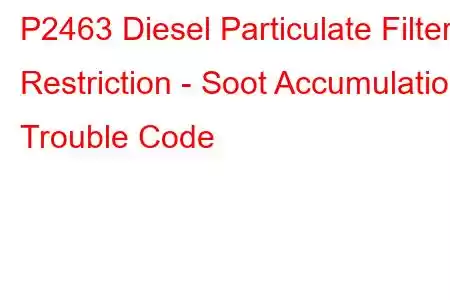P2463 Diesel Particulate Filter Restriction - Soot Accumulation
OBD-II Trouble Code Technical Description
Diesel Particulate Filter Restriction - Soot Accumulation
What does that mean?
This diagnostic trouble code (DTC) is a generic powertrain code, which means that it applies to all 1996-newer diesel vehicles (Ford, Mercedes Benz, Vauxhall, Mazda, Jeep, etc.). Although generic, the specific repair steps may vary depending on make/model.
In my encounters with a stored code P2463, the powertrain control module (PCM) has detected a restriction (due to soot accumulation) in the diesel particulate filter (DPF) system. This code should be exhibited only in diesel powered vehicles.
Because DPF systems are designed to remove ninety-percent of carbon particles (soot) from diesel engine exhaust, soot accumulation can sometimes lead to DPF restriction. DPF systems are critical in facilitating automaker’s compliance with strict federal guidelines for clean burning diesel engines. Modern diesel powered vehicles smoke far less than the diesel powered vehicles of yesteryear; primarily due to DPF systems.
Most PDF systems function in a similar manner. The DPF housing resembles a large steel muffler which contains a filtration element. Theoretically, large soot particles are trapped by the filtration element and exhaust gases are allowed to flow through and exit the tailpipe. In the most common design, the DPF contains wall fibers that attract larger soot particles as they flow into the housing. Less common designs rely on a loose web assembly that fills virtually the entire housing. Openings in the filtration device are sized so that larger soot particles are trapped within; exhaust gases flow through and exit the tailpipe.
When the filtration element has accumulated an excessive amount of soot particles, it becomes partially clogged and exhaust back pressure increases. DPF back pressure is monitored by the PCM using a pressure sensor. Once back pressure reaches a programmed limit, the PCM initiates a regeneration procedure of the filtration element.
Cutaway photo of a diesel particulate filter (DPF):
A minimum temperature of 1,200-degrees Fahrenheit must be reached (inside the DPF) in order for the filtration element to be regenerated. The regeneration system uses a specialized injection system to accomplish this. The electronically controlled (by the PCM) injection procedure introduces a flammable chemical compound, such as diesel fuel or diesel exhaust fluid, into the DPF. Once the specialized fluid has been introduced, soot particles are incinerated and released into the atmosphere (via the tailpipe) as harmless ions of nitrogen and water. Once the PDF is regenerated, exhaust back pressure drops within acceptable limits.
Active DPF regeneration systems are initiated automatically by the PCM. The process usually occurs while the vehicle is being driven. Passive DPF regeneration systems require driver interaction (after the PCM has presented a cautionary warning) and normally take place after the vehicle is parked. Passive regeneration procedures may take hours to complete. Check your vehicle information source to see with which type of DPF system your vehicle is equipped.
If the PCM detects exhaust pressure levels that fail to reach a programmed limit, a P2463 will be stored and a malfunction indicator lamp (MIL) may be illuminated.
Severity & Symptoms
Because DPF restriction may lead to engine or fuel system damage, this code should be considered severe.
Symptoms of a P2463 code may include:
Other DPF and DPF regeneration codes will likely accompany a stored code P2463 Excessive black smoke from the exhaust Inability to produce and maintain desired RPM levels Increased engine temperature Overheated DPR housing or other exhaust componentsCauses
Possible causes for this
Read: 28


